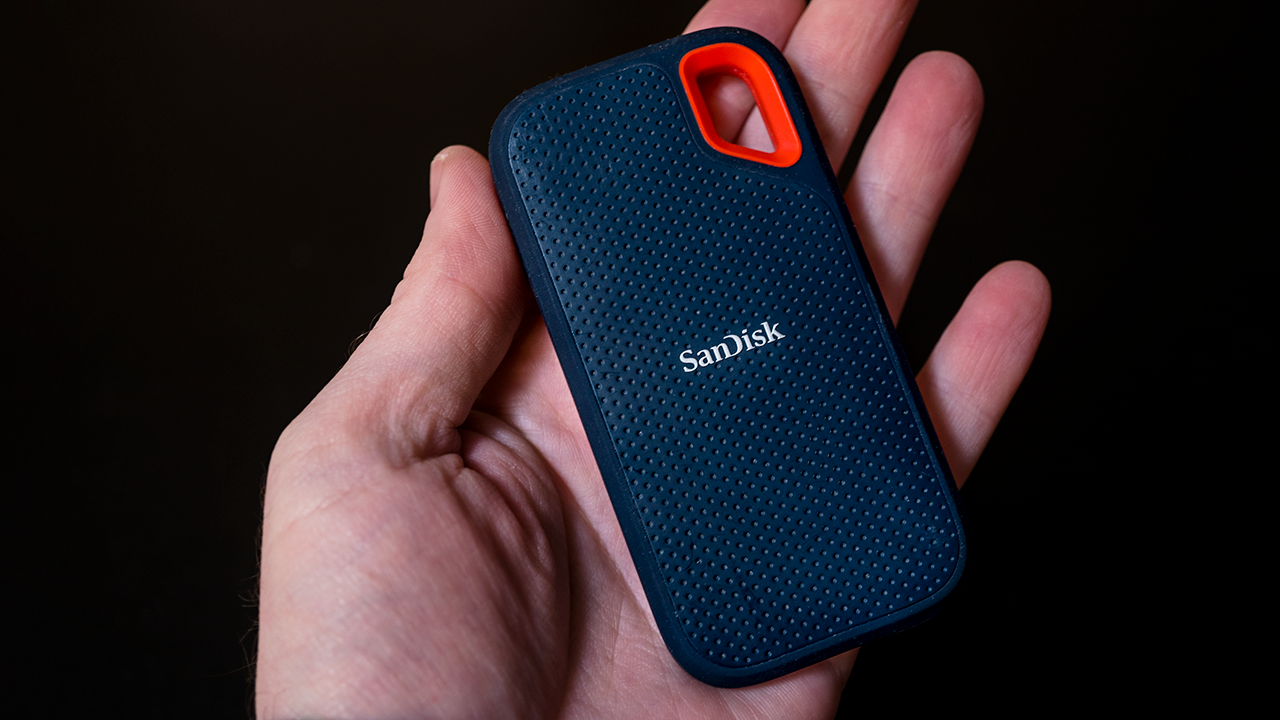Last year we received a number of portable storage solutions for review which we will be testing in a row in the next few weeks. The first will be the SanDisk Extreme Portable SSD.
This tiny unit, weighing 40g or 1.4 oz and measuring 9cm or 3.5 inches long over 4.5cm or under 2″ wide, is made of semi-porous rubberized material and is quite nice to the touch (although it does tend to attract some dust over time into those tiny holes).
The drive has no buttons or switches of any sort and the only connector is a single USB-C on the lower side. It also has a red square at the top for connecting a carabineer for example. It comes with a single short USB-C to USB-C cable plus a USB-C to USB-A adaptor (make sure you use this or a similar fast data transfer cable – we used a longer USB-C to USB-C cable and got really dreadful transfer speeds – using such a short cable on a desktop is a bummer though).
The drive is pretty rugged and has an IP55-rating and is water, shock and coldproof to a degree and comes with 3 years warranty.
The SanDisk Extreme Portable SSD
As for performance, we have actually been waiting for our brand new super fast studio computer to arrive in order to perform this test (this behemoth has a Core i9-9900K processor, 32GB of RAM with an Asus RTX 2070 GPU and Z390 Gigabyte DESIGNARE motherboard with built-in dual TB3 ports and two Samsung 970 NVME drives running with the latest win 10 Pro).
We have conducted both synthetic tests using CrystalDiskMark 6.0.2 and real-world transfer tests where we moved a number of larger and smaller video files from our computer to the drive and back.
CrystalDiskMark scores showed impressive 476MB/s read and even faster 487MB/s write this isn’t the max rating of the drive (or most non NVME SSDs for that matter) which is stated by the manufacturer at up to 550MB/s (with internal drives like the Samsung 860 EVO we did get faster speeds but for a portable external SSD – this is pretty solid) .
On the real world test, our scores were a bit peculiar. We were able to transfer 5.65GB of files to the drive in under 15 seconds which is about 380MB/s but interestingly sending the same files to the desktop took just over 2 seconds which is closer to 3000MB/s which makes no sense to us (possibly the files where somehow retained by the computer’s memory or something similar – if you have other thoughts on that – let us know).
We have been using the drive for several months now as our primary video editing drive on our home office desktop and it performed very well (although we will be replacing it with an internal NVME SSD very soon) and it performed very well with no issues whatsoever.
As for pricing, the 1TB drive that we have been testing currently sells for $200 or about $0.2 per Gigabyte. The larger 2TB version is a little more cost effective at $368 while the 500GB is somewhat less cost-effective at $105. Compared to similar units, the drive is somewhat less expensive per Gigabyte than the Samsung T5 and a little bit more expensive than the WD My Passport SSD which we will be testing here soon as well.
Finally, it’s worth noting that we are definitely waiting to test future portable NVME based SSDs which are going to push the bar significantly higher in the next few years.
You can check out more LensVid exclusive articles and reviews on the following link.

You can support LensVid by shopping with our affiliate partners
Affiliates: Amazon, B&H, Adorama and E-bay.
Why should you trust us?